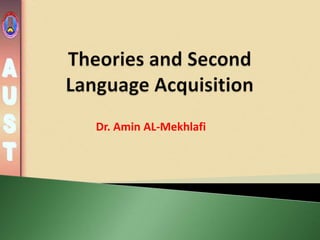
Lecture 7. theories explaining second language (2)
- 2. The Cognitive/Developmental Perspective The Computer Analogy Storing Integrating Retrieving They see no need to believe that: humans have language specific device. acquisition and learning are different. They believe in: The general theory of learning (the gradual development of knowledge).
- 3. The Cognitive/Developmental Perspective Information Processing Model In IPM, SLA is seen as building up of knowledge This knowledge becomes automatic during speaking and understanding Paying Attention Practice Automaticity
- 4. Paying attention uses some cognitive resources. Beginners vs. Proficient language users. There is a limit to the amount of information a human can pay attention to and learn at one time. Gradually, through experience and practice, learners become able to use certain parts of the language automatically.
- 5. Practice includes: Language production Being exposed to language Language comprehension Practice makes language processing easier and automatic.
- 6. Other cognitive psychologists say that SLA is like learning any other skill starting as declarative knowledge and then changing into procedural knowledge. Declarative Knowledge Procedural Knowledge Information that we have Knowledge that underlies and know we have. All fluent or automatic learning begins with performance. Also referred to declarative knowledge. It is as 'knowledge how’. sometimes referred to as 'knowledge that'.
- 7. The Cognitive/Developmental Perspective Information Processing IPM SLA is like skill learning Procedural Knowledge Information that we have Knowledge that underlies and know we have. All fluent or automatic learning begins with performance. Also declarative knowledge. It referred to as 'knowledge is sometimes referred to as how’. 'knowledge that'.
- 8. Restructuring Model: Refers to the interaction of knowledge we already have, or on the acquisition of new knowledge (without extensive practice) which fits into an existing system and causes it to be restructured Sudden bursts of progress and backsliding may not be explainable in terms of a gradual build-up of automaticity through practice. They seem rather to be based on.
- 9. Connectionists argue that innate is simply the ability to learn, not any specifically linguistic structure. They attribute greater importance to the role of the environment in language learning. They see the frequency of the input as the principal source of linguistic knowledge. Learners develops stronger mental ‘connections’ between language elements s/he has learned, and the situational or linguistic contexts in which they occur.
- 10. “He says” “I say” The learner will produce the “She says” correct form not because he/she knows the rule, but because he/she has heard such uses very often and the presence of the subject ‘he or she’ activates the mind to call on the correct verb form.
- 11. The Interaction Hypothesis The Noticing Hypothesis Input Processing
- 12. 1. Researchers within this perspective argue that conversational interaction is an essential condition for second language acquisition. 2. Comprehensible input is important. 3. How to make input comprehensible?
- 13. Interactional modification makes input Comprehensible comprehensible. input promotes acquisition. Therefore Interactional modification promotes acquisition.
- 14. Modified interaction does not always involve linguistic simplification. It may also include: Elaboration Slower speech rate Gesture The provision of additional contextual cues Examples of Comprehension checks Clarification requests modifications Self-repetition or paraphrase
- 15. Nothing is learned unless it has been noticed. Learners realize certain language features. These features will enter the learners’ own second language system. L2 learners could not begin to acquire a language feature until they had become aware of it in the input.
- 16. Vygotsky’s Sociocultural Theory Language development takes place in the social interactions between individuals. L2 learners advance to higher levels of linguistic knowledge when they interact with knowledgeable speakers. Learning occurs when the interaction takes place at the learner’s zone of proximal development (ZPD).
- 17. The ZPD is the difference between what a learner can do without help and what he or she can do with help.
- 18. Learning is thought to occur when an individual interacts with an interlocutor within his or her zone of proximal development (ZPD)-that is, in a situation in which the learner is capable of performing at a higher level because there is support from an interlocutor.
- 19. The ZPD Krashen's i+ 1 The Z P D is a metaphorical In Krashen's i+ 1, the input location in which learners co- comes from outside the learner construct knowledge in and the emphasis is on the collaboration with an comprehensibility of input that interlocutor. includes language structures that are just beyond the The emphasis in ZPD is on learner's current development and how developmental level. learners co-construct knowledge based on their interaction with their interlocutor.
- 20. There is no agreement on a “complete” theory of second language acquisition yet. Each theoretical framework has a different focus and it has its limitations. 1. Behaviorism: emphasizing the role of the environment, but ignoring the mental processes that are involved in learning.
- 21. 2. Innatism: emphasizes the role of innate abilities. But it is based on intuitions and not solid evidence. 3. Information processing and connectionism: involving controlled laboratory experiments where human learning is similar to computer processing. 4. Interactionist position: modification of interaction promotes language acquisition and development.
